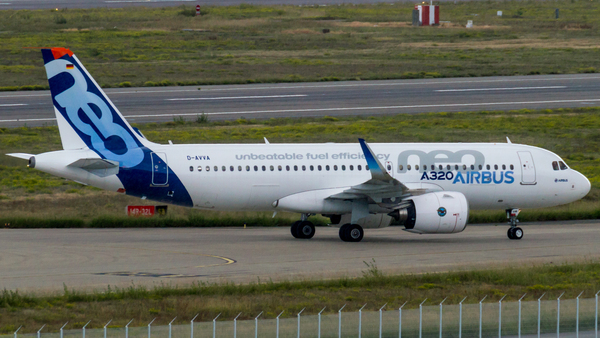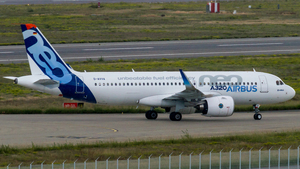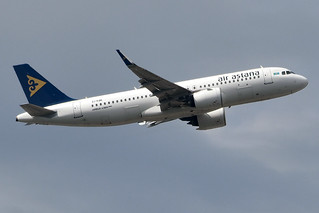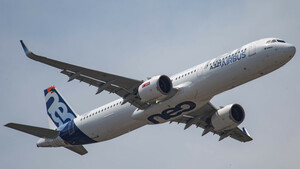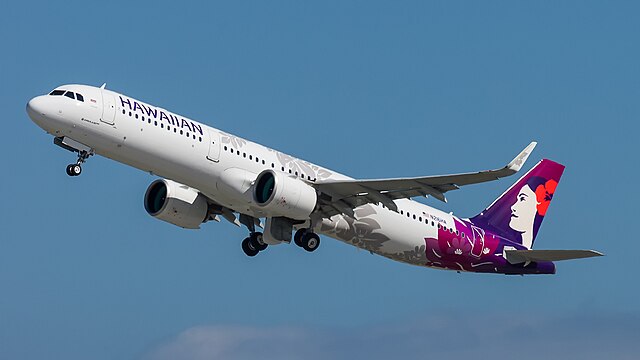Astana E190 at Alverca on Nov 11th 2018, severe control problems
Last Update: June 24, 2020 / 22:15:08 GMT/Zulu time
Incident Facts
Date of incident
Nov 11, 2018
Classification
Accident
Airline
Air Astana
Flight number
KC-1388
Departure
Alverca (Portugal) to Minsk, Belarus
Destination
Almaty, Kazakhstan
Aircraft Registration
P4-KCJ
Aircraft Type
Embraer ERJ-190
ICAO Type Designator
E190
Portugal's GPIAA rated the occurrence a serious incident and reported on Nov 14th 2018: "All on board were physically and emotionally shaken, one of the passengers sustaining a leg injury." The investigation is ongoing, the GPIAA commented: "Still pending confirmation from the undertaking of additional testing, the evidence that was possible to collect at the time of drafting this Note suggests the existence of failures in the aircraft roll controls configuration, consistent with possible disturbance during maintenance actions."
The aircraft had undergone maintenance in Alverca and was on its first flight after maintenance.
The GPIAA described the sequence of events:
The flight KC1388 had as final destination the operator base at Almaty, Kazakhstan, with a refueling stopover at Minsk, Belarus.
On board there were three crewmembers (a captain and two copilots), and three technicians from the operator.
Immediately after takeoff, with adverse meteorological conditions, the crew felt that the aircraft was not responding adequately to the commands, developing oscillatory wing movements.
The crew, using all the aircraft control resources for its 3 axis, immediately tried to counter the movements, however without understanding the cause for the flight instability and without being able to engage the autopilot.
Realising that they were without effective control of the aircraft, only being able – with considerable effort – to minimize the oscillatory movements, with high structural loads involved during some recovery manoeuvres and using crossed commands.
The crew immediately declared emergency while trying to diagnose the cause for the abnormal roll of the aircraft, continuing to struggle to gain its control, having no malfunction indication from the aircraft systems, just the continuous alerts for abnormal flight attitudes.
The situation did not improve, and the performed trajectories caused the aircraft and the persons on board to sustain intense G-forces, and causing the aircraft complete loss of control for some moments at multiple instances.
Considering the situation criticality, the crew requested several times for headings in order to be able to reach the sea for ditching, not being able, however, to keep the intended headings.
The crew then started a team work basis, discussing options with the third crewmember (copilot in the jumpseat) and trying to communicate with the technicians on board, to explore hypothesis and define an action plan.
Despite no warnings for system failures, the crew decided to activate the flight controls direct mode (elevators, rudder and spoilers), where the flight control module (FCM) is removed from the flight surfaces command chain, which are then controlled in a direct relationship with the pilots’ inputs on the yoke.
The situation improved considerably, however, without restoring normal operation and keeping the difficulties to control the aircraft roll-axis.
The crew realised that the ailerons were behaving erratically and therefore any command for the aircraft roll was kept to its minimum.
Having gained some control of the situation, the crew flew East, searching for better weather conditions and started to follow the flight plan defined by the air traffic control for an emergency landing in a suitable airport, with good weather and physical conditions to deal with the sustaining aircraft control difficulties.
At this moment, when the pilots were able to keep altitude and heading, and had sufficient visual references, the aircraft was joined by a pair of F-16 fighters from the Portuguese Air Force, which assisted in guiding to Beja airport, which had been selected in the meantime as the best emergency landing option. After two non-stabilised approaches, the aircraft managed to land safely on runway 19L at the third approach. The intended runway was 19R, but due to drift, they finally managed to land on the left runway.
All on board were physically and emotionally shaken, one of the passengers sustaining a leg injury.
Still pending confirmation from the undertaking of additional testing, the evidence that was possible to collect at the time of drafting this Note suggests the existence of failures in the aircraft roll controls configuration, consistent with possible disturbance during maintenance actions.
On May 31st 2019 the GPIAA changed the classification of the occurrence from serious incident to accident. The GPIAA released their preliminary report and provided preliminary findings:
The left and right aileron surfaces control the rolling (lateral) movements of the aircraft with the actuation of the two control yokes or with the autopilot controls. The ailerons are assisted by the flight mode spoilers (roll spoilers).
The aileron control system is actuated by rotation of either the pilot or co-pilot aileron control yokes which are mechanically connected to each other and that through the cable circuit, the torque tubes and the quadrants, transmit these movement to the Power Control Unit - PCU which moves the aileron surface.
The PCUs are mechanically controlled through the cable system and are hydraulically powered.
The data collection during the initial investigation phase included a detailed examination of the aircraft flight controls and an incorrect ailerons control cable system installation was confirmed on both semiwings.
By introducing the modification iaw Service Bulletin 190-57-0038 during the maintenance activities, there was no longer the cable routing and separation around rib21, making it harder to understand the maintenance instructions, with recognized opportunities for improvement in the maintenance actions interpretation.
The message “FLT CTRL NO DISPATCH” was generated during the maintenance activities, which in turn originated additional troubleshooting activities by the maintenance service provider, supported by the aircraft manufacturer. These activities, which lasted for 11 days, did not identify the ailerons' cables reversal, nor was this correlated to the "FLT CTRL NO DISPATCH" message.
From the investigation process carried out so far, it also resulted in the identification of deviations to the internal procedures by the maintenance service provider, which led to the error not being detected in the various safety barriers designed by the regulators, aeronautical maintenance industry and within the maintenance service provider implemented system.
The ailerons incorrect operation caused by the control cables reversal, was not identified in the aircraft operational checks (flight controls check) by the operator crew.
The GPIAA reported the damage:
From the preliminary analysis to the condition of the aircraft after the event flight, significant structural damage in both semi-wing, fuselage and flight control surfaces was verified, which led the GPIAAF to change the initial classification of serious incident to accident, following ICAO Annex 13 recommendations.
The aircraft was returned to the operator on Jan 21st 2019, who is currently evaluating the aircraft and deciding about further action. The investigation has completed the collection of facts and is now engaging in analysis and drafting the final report.
On Jun 24th 2020 the GPIAA released their final report concluding the probable causes of the accident were:
The investigation determined as most probable cause for the accident the improper aileron cable installation on both semi-wings during maintenance activities and subsequent inadequate independent inspection to the aircraft flight control systems, which resulted in a reversal operation of the aircraft aileron system and led to loss of control in-flight.
Contributing factors were:
- Insufficient functioning of the AMO quality assurance and failure to implement an effective production oversight, including but not limited to the independent inspection procedures to detect maintenance escapes;
- The AMO lack of proper risk management, based on an effective SMS program with maintenance escapes reporting system;
- The lack of maintenance teams properly managed and organized by skills and specialties, with the necessary training and experience;
- Weaknesses in the aircraft design, referring to the ailerons control system configuration, allowing the inverted cables installation in both PCU quadrants;
- The aircraft manufacturer’s inaccurate depiction, complex and limitations on presentation of the aileron cables routing maintenance publications;
- The lack of proper guidance or best practices from the OEM to the operator and AMO regarding aircraft acceptance and return to service, after a heavy or complex maintenance event;
- The poor supervision of the maintenance organisation by the operator;
- Deficient maintenance organisation oversight by the supervising authorities, namely on the internal maintenance supervision procedures and occurrence reporting;
- The lack of proper guidance from the operator to the crew regarding aircraft acceptance after a heavy maintenance event;
- The crew failure to detect the ailerons misconfiguration during the operational check procedures following limited SOP’s on the highly routine pre-flight checks;
The GPIAA analysed:
The evidence gathered by the investigation regarding AMO competency assessments suggests that these assessments were carried out from a perspective of legal compliance. This means that there is a system in place, but it is only built as an administrative procedure supported on legal minimum requirements, far from the opportunity of delivering best practice which ensures effective aircraft maintenance competence assessment and training.
The events sequence during the scheduled maintenance activities (until 31 OCT) and in some moments on the troubleshooting phase (from 1 to 11 NOV) evidenced a team with lack of solid technical knowledge in the E190 product, as well as weaknesses in the maintenance planning and preparing for both scheduled or unscheduled work.
The non-interpretation of the ailerons physical position relative to the spoilers, considered relevant aerodynamic evidence, indicates a lack of basic aircraft systems understanding and raises questions indeed about the basic aeronautical training of the involved technicians in the numerous tests performed with aircraft flight control surfaces physical movement.
...
Throughout the productive maintenance process of the accident aircraft, numerous opportunities for error/deviation detection were wasted.
The events sequence identified by investigation reveals, among other problems, the lack of effective safety barriers implementation in the production process, all of them perfectly defined in the regulations and on the specific maintenance procedures. The implemented system with the demonstrated aeronautical culture weaknesses allowed a maintenance action, not identified as a deviation by the error capture system, to be hidden covered with a supposed technical failure of a component or equipment.
The referred aircraft design configuration deviation (cable inversion) was not detected in the numerous modifications, tasks and sub-tasks performed on the aircraft system by different technicians with double-check (DC), including the dedicated team, who worked in detail on the affected system for 11 days, in an attempt to solve the aircraft non-dispatch message.
It is then probable, that the aircraft did not present any issues that justifies the FLT CTR NO DISPATCH condition; it was simply not possible to eliminate this message due to the CBIT not completed validation routine and clear the FCM NVM during the RTS procedure.
...
The maintenance organization is certified by the Aruba authority, with which it carried out the work and issued the aircraft's return to service certificate.
...
As demonstrated by facts, it is possible to invert the Embraer 170/190 aileron controls operation, by the control cables swap in their last section and without an automatic detection or message.
However, it should be noted that the control cables swap was perceptible by the correct execution of the aileron system operational test, by the surface deflection observation on the Synoptic page and cross check the surface physical deflection versus the control yoke displacement.
The investigation followed an extensive and comprehensive engineering analysis on the chain of events that started with the difficulty to clear the FLT CTRL NO DISPATCH after the aileron control cables were misconfigured and ended with the same CAS message not present in the hours before the accident's flight, although with red indication on the roll axis on the FCM (1A, 1B, 3A, 3B, 4A and 4B) status in red, during the flight control return to service procedure, providing evidence that probably was not successfully completed, as per figures 17 and 28. However, the post-event performed tests, confirmed that the FLT CTRL NO DISPATCH message would not result only from an aileron control cable reversal.
...
The lessons learned from this event allowed the manufacturer to add and predict the inverted cables condition in the new maintenance procedure described in 1.18.2.3 and exemplified in the respective figure with the new CMC page for ailerons condition operational check.
...
The abnormal attitudes experienced during the accident flight were, in some cases, extreme and well outside the aircraft’s normal flight envelope. These abnormal attitudes were the result of the aileron misconfiguration, combined with, the slats/flaps configuration, the relatively low speed and the crew’s reaction to aircraft roll by using control wheel inputs consistent with normal operation and their experience and training.
The use of flight controls in direct mode, as detailed in 1.6.5.1, facilitated the aircraft control mainly by limiting the deflection of the roll spoilers, which, although acting in the correct direction, acted in opposition to the ailerons.
The roll spoilers acting correctly, made it impossible for the crew to apply the reversed controls (yoke), after detecting the discrepancy on the aileron inversion.
Metars Alverca:
LPAR 111500Z 04005KT 3500 -RADZ SCT005 SCT010 BKN015 13/12 Q1010=
LPAR 111400Z 35005KT 2000 -RA SCT005 SCT010 BKN015 13/13 Q1010=
LPAR 111300Z 04005KT 3000 RA FEW005 SCT010 BKN015 14/13 Q1010=
LPAR 111200Z 35013KT 3000 RA BKN010 BKN015 14/13 Q1010=
LPAR 111100Z 22008KT 8000 VCSH SCT010 BKN015 18/17 Q1011=
LPAR 111000Z 22009KT 9999 SCT010 BKN015 18/17 Q1011=
Metars Beja:
LPBJ 111700Z 21013KT 8000 3000NE -RADZ FEW004 BKN020 16/15 Q1010=
LPBJ 111630Z 20019KT 3000 -RADZ BR FEW007 BKN020 BKN035 18/14 Q1010=
LPBJ 111600Z 20018KT 9999 FEW020 SCT030 BKN045 19/13 Q1010=
LPBJ 111520Z 20017KT 9999 SCT030 BKN048 19/13 Q1010=
LPBJ 111500Z 20019KT 9999 SCT030 BKN048 19/14 Q1010=
LPBJ 111400Z 19017KT 9999 SCT030 BKN048 19/14 Q1011=
LPBJ 111300Z 20016KT 9999 SCT025 BKN045 20/13 Q1012=
LPBJ 111200Z 19015KT 9999 FEW018 BKN040 19/14 Q1013=
LPBJ 111100Z 20015KT 9999 FEW015 BKN040 19/15 Q1014=
Incident Facts
Date of incident
Nov 11, 2018
Classification
Accident
Airline
Air Astana
Flight number
KC-1388
Departure
Alverca (Portugal) to Minsk, Belarus
Destination
Almaty, Kazakhstan
Aircraft Registration
P4-KCJ
Aircraft Type
Embraer ERJ-190
ICAO Type Designator
E190
This article is published under license from Avherald.com. © of text by Avherald.com.
Article source
You can read 2 more free articles without a subscription.
Subscribe now and continue reading without any limits!
Read unlimited articles and receive our daily update briefing. Gain better insights into what is happening in commercial aviation safety.
Send tip
Support AeroInside by sending a small tip amount.
Related articles
Astana A20N at Aktau on Mar 8th 2025, engine shut down in flight
An Air Astana Airbus A320-200N, registration EI-KBM performing flight KC-858 from Aktau to Almaty (Kazakhstan), was climbing out of Aktau's runway 29…
Astana A321 near Aktau on Jan 8th 2025, fuel problem
An Air Astana Airbus A321-200, registration EI-KGK performing flight KC-915 from Almaty (Kazakhstan) to Antalya (Turkey), was enroute at FL320 about…
Astana A20N at Mumbai on Feb 22nd 2024, runway incursion
An Air Astana Airbus A320-200N, registration EI-KBP performing flight KC-7858 from Mumbai (India) to Almaty (Kazakhstan), was taxiing for departure…
Astana A20N at Almaty on Sep 17th 2023, engine failure
An Air Astana Airbus A320-200N, registration EI-KBK performing flight KC-127 from Almaty (Kazakhstan) to Tashkent (Uzbekistan), was climbing out of…
Astana A21N enroute on Jan 2nd 2023, turbulence injures 7
An Air Astana Airbus A321-200N, registration EI-KDF performing flight KC-128 from Tashkent (Uzbekistan) to Almaty (Kazakhstan), flew threw severe…
Newest articles
How to Prepare for Flights to Asia: Key Packing Tips
Asia, especially its south-eastern part, is among the world's most beautiful and thrilling destinations. You can experience it all, from cultures and…
Hawaiian A21N and private C172 at Long Beach on Oct 26th 2023, near midair collision
A Hawaiian Airlines Airbus A321-200N, registration N216HA performing flight HA-70 from Honolulu,HI to Long Beach,CA (USA), was cleared to land on…
Subscribe today
Are you researching aviation incidents? Get access to AeroInside Insights, unlimited read access and receive the daily newsletter.
Pick your plan and subscribePartner

ELITE Simulation Solutions is a leading global provider of Flight Simulation Training Devices, IFR training software as well as flight controls and related services. Find out more.
SafetyScan Pro provides streamlined access to thousands of aviation accident reports. Tailored for your safety management efforts. Book your demo today
AeroInside Blog
Popular aircraft
Airbus A320Boeing 737-800
Boeing 737-800 MAX
Popular airlines
American AirlinesUnited
Delta
Air Canada
Lufthansa
British Airways
